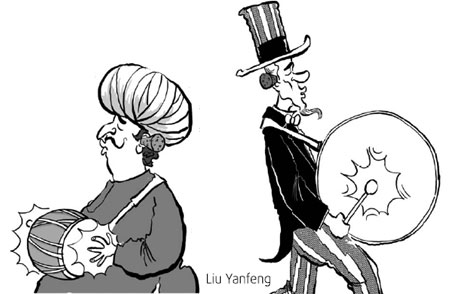
|
OPINION> OP-ED CONTRIBUTORS
 |
|
Some hits, some misses on Clinton's India visit
By Swaran Singh (China Daily)
Updated: 2009-07-24 07:48 George W. Bush's eight years in the White House transformed the tenor of India-US ties, especially in the defense and nuclear fields. In the backdrop of that legacy of hype and hyperactivity, US President Barack Obama's efforts to revive the arms control agenda, especially the comprehensive test ban and fissile material cut-off treaties, his support for climate change negotiations leading up to the Copenhagen conference in December, and his perspective on terrorism and Kashmir, asking India to open peace talks with Pakistan, have created serious misgivings in New Delhi. It is in this context that US Secretary of State Hillary Clinton's July 18-21 visit to India opened a new chapter. The itinerary and agenda of Clinton were unusual. She began her visit from Mumbai, India's commercial capital, instead of the political capital, New Delhi, staying at Taj Hotel for two days. Her stay at the Taj was to express her solidarity with the victims of the Nov 26, 2008, attacks, she said. The attack on the Taj and several other places in Mumbai killed 186 people, including about a dozen Americans and other foreigners. Her engagements in Mumbai ranged from the media, educational institutions, the business community and civil society. In New Delhi, however, her agenda was more focused on evolving a new dialogue regime for deepening Indo-US strategic cooperation, discussing regional issues, finalizing all the aspects of a civil nuclear deal, reconciling views on climate change, fighting non-proliferation and terrorism and devising a set of rules for fair global trading.
 Indian Prime Minister Manmohan Singh told Clinton that India had chosen two sites - in Gujarat and Andhra Pradesh provinces - to set up US-made nuclear power reactors. The decision is seen as a continuation of Bush's policies of increasing interactions with India and providing it greater access to US nuclear materials and technologies. The two countries concluded the End User Monitoring Agreement (EUMA), Science and Technology Endowment Agreement and the Technology Safeguards Agreement, which will help India launch civil and non-commercial satellites containing US components. The US welcomed India's participation in FutureGen Project for construction of the first commercial-scale carbon capture and sequestration project. India's participation in the Integrated Ocean Development Project, an international endeavor for understanding Earth and ocean dynamics to fight climate change, was welcomed too. The two countries agreed to start an annual "Indo-US Strategic Dialogue" at the foreign ministers' level, with the first scheduled for next year in Washington. Back in the US, Obama submitted to US Congress last Tuesday his first update on the US-India Nuclear Cooperation Approval and Non-proliferation Enhancement Act of 2008, which is seen in the US as an initiative toward ensuring India's non-proliferation credentials. Many details of this report are unlikely to be made public. The EUMA is seen as her big take-away from India. It will open the doors for Boeing and Lockheed Martin to sell their high-tech military technologies to New Delhi. To begin with, India can place an order of 126 fighter jets worth $10 billion. The EUMA had been under discussion for some time, and India was reluctant to allow "intrusive" inspection of its military bases that used US equipment and components. But US law required India approve the agreement, and Clinton managed to clinch that. Nonetheless, the EUMA has become a major controversy even before Clinton left New Delhi for Phuket, Thailand, on July 21 to attend the ASEAN Regional Forum. The agreement has worked as glue to unite the entire opposition in India, which describes it as a compromise on India's security and sovereignty. The entire opposition walked out of parliament when the foreign minister read out a statement on the conclusion of Clinton's visit. The Indian government's efforts to describe it as continuation of the India-US Defense Cooperation Framework Agreement of 2005 and give an assurance that intrusive inspections are not part of the deal have cut little ice with the opposition. Another $10-billion deal is likely to be signed for the sale of power reactors. Though the two countries began talks in Vienna on July 21 on sensitive reprocessing arrangements and procedures, the deal had generated enough controversy even before Clinton left India. Asked by the media about the new draft rules of Nuclear Suppliers Group (revised para 6 & 7 of INFCIRC 254/part I) that bans sale of enrichment and reprocessing items to India, Clinton appeared unclear about it. Even besides that, it was not sweet talk all the way for Clinton, with Indian Minister for Environment and Forest standing his ground by saying India will not be willing to compromise developmental needs to meet binding greenhouse gas emission cuts. He highlighted India's concerns over carbon tariff threats emanating from developed world, including the US. Clinton conceded, though that the US and India continue to have "different views" on several issues and that Washington is eager to "work through" these divergent views. On Iran, more specifically, the two countries, had "lot to discuss", though both felt that global security would be threatened if Teheran developed nuclear weapons. In the end, Clinton's visit looks like her first brush with forces of continuity, which remains at the core of India's foreign policy. The author is professor of Diplomacy & Disarmament at Jawaharlal Nehru University, New Delhi. (China Daily 07/24/2009 page9) |